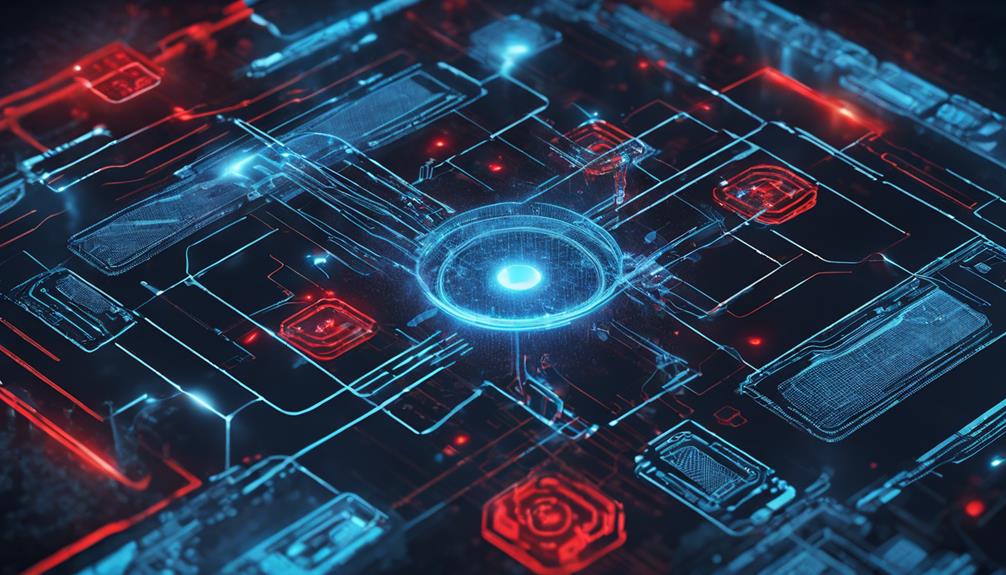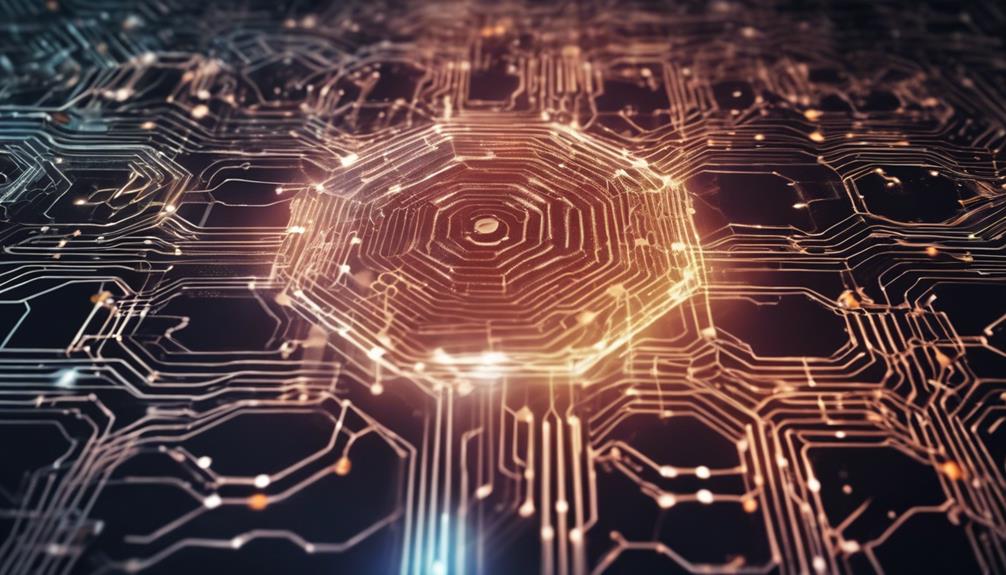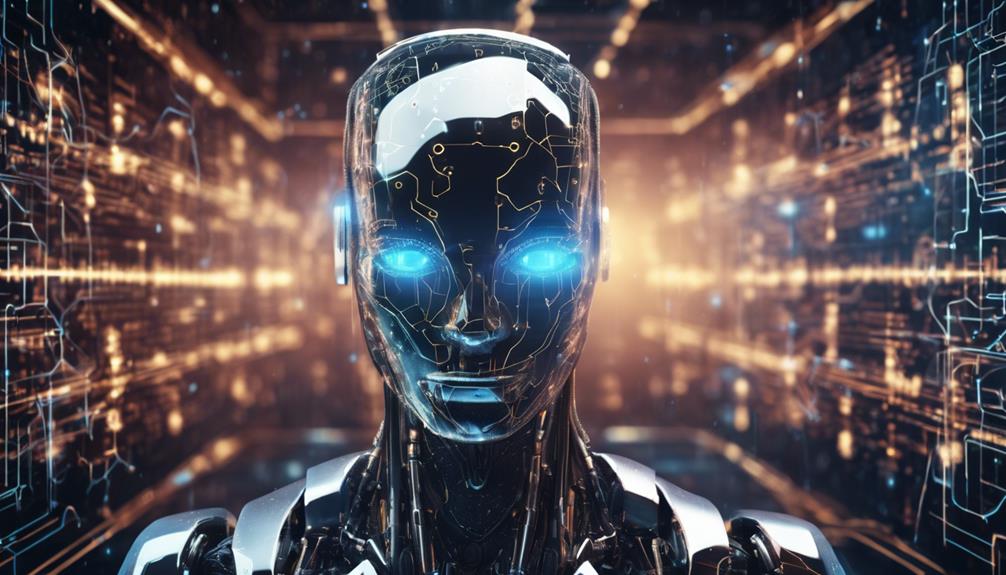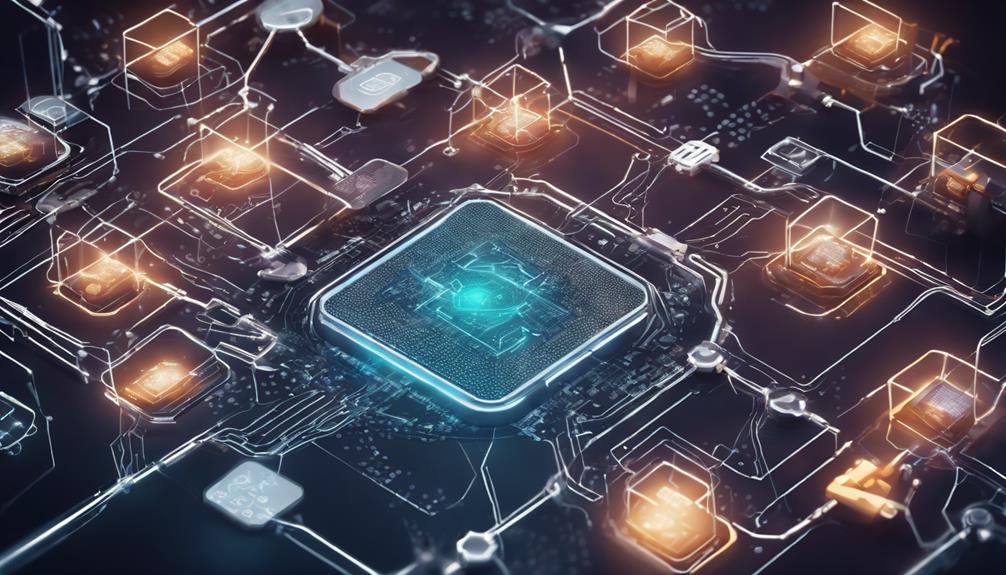The domain of cybersecurity is undergoing a transformation as artificial intelligence (AI) is increasingly incorporated. AI boosts threat detection and response capabilities by analyzing vast data swiftly, providing advanced threat intelligence for security teams. This integration signifies a remarkable advancement in shielding digital assets. The future implications suggest AI will reshape defense strategies, enhance preventive measures, and revolutionize the cybersecurity job market. As AI tools evolve to detect threats efficiently and foster collaboration between AI and human expertise, organizations can bolster their cybersecurity posture. Discover more about the impact and potential of AI in cybersecurity.
Key Takeaways
- AI enhances cybersecurity by revolutionizing threat detection.
- Human expertise remains crucial in cybersecurity operations.
- AI automates tasks to improve response times and accuracy.
- AI and human collaboration strengthen defense strategies.
- Privacy concerns are addressed through responsible data handling.
AI Integration in Cybersecurity
With the advancements in technology, the integration of AI in cybersecurity has greatly transformed the landscape of threat detection and incident response procedures. AI, through its ability to analyze vast amounts of data at unparalleled speed and scale, has become an essential component in enhancing security measures against cyber threats.
By leveraging AI integration, security teams can now benefit from advanced threat intelligence that enables the swift identification and mitigation of potential risks.
Incorporating AI into cybersecurity strategies not only improves threat detection capabilities but also enhances incident response times, allowing for more proactive defense mechanisms. This shift towards AI-driven security solutions marks a significant progression in safeguarding digital assets from evolving cyber threats.
As the human element collaborates with AI technologies, the synergy created between human expertise and AI algorithms results in a formidable defense against malicious cyber activities.
Embracing AI integration in cybersecurity is vital for staying ahead of cyber threats in today's increasingly digital world.
Future Implications of AI

Advancements in AI integration within cybersecurity are paving the way for significant future implications in reshaping defense strategies against cyber threats. As AI continues to evolve in the cybersecurity domain, here are three key future implications to ponder:
- Enhanced Threat Detection:
AI systems are revolutionizing threat detection by rapidly analyzing vast datasets to identify potential risks and vulnerabilities in real-time. This proactive approach enables organizations to stay ahead of cyber threats and respond swiftly to mitigate potential damages.
- Predictive Security Measures:
The potential for AI in cybersecurity is vast, allowing for the development of predictive security measures that anticipate and prevent cyber attacks before they occur. By leveraging AI strategies, organizations can strengthen their defenses and adapt to evolving threats effectively.
- Accessible Defense Solutions:
As AI becomes more prevalent in cybersecurity, the accessibility and affordability of AI-driven security solutions are expected to increase. This trend will empower smaller organizations to implement robust cybersecurity measures, bolstering their defense against sophisticated cyber threats.
The influence of AI on cybersecurity is undeniable, reshaping how organizations protect their digital assets in the face of an increasingly complex threat landscape.
Cybersecurity Job Market Trends

The evolving landscape of the cybersecurity job market reflects a growing demand for skilled professionals to address the increasing complexities of cyber threats. With projections indicating a staggering 3.5 million unfilled cybersecurity positions by 2025, the industry is facing a critical talent shortage and skills gap.
Securing entry-level roles in cybersecurity is becoming more challenging without prior experience. However, the integration of AI in cybersecurity is poised to revolutionize the job market. AI-powered tools not only enhance the capabilities of cybersecurity professionals by automating tasks and improving efficiency but also create new job opportunities.
AI Tools in Threat Detection

AI tools play a pivotal role in enhancing cybersecurity efforts by analyzing data to identify patterns and anomalies for potential cyber threats. These tools, powered by machine learning algorithms and deep learning, are revolutionizing threat detection in the digital landscape.
Here are key ways AI tools are transforming threat detection:
- Unmatched Processing Power: AI tools process vast amounts of data at incredible speeds, enabling cybersecurity professionals to stay ahead of evolving threats.
- Automated Incident Response: AI tools automate incident response processes, allowing for swift detection and response to malicious software and cyberattacks.
- Real-time Monitoring: AI tools supervise and analyze data sets in real-time, enabling the rapid identification and mitigation of security breaches.
The rapid evolution of AI technology in cybersecurity is reshaping security measures and incident response strategies, equipping organizations with powerful tools to combat emerging cyber threats effectively.
Balancing AI and Human Expertise

Balancing AI and human expertise in cybersecurity is essential for maximizing the strengths of both domains. By integrating AI tools with human intuition, organizations can achieve a dynamic synergy that enhances threat detection and response strategies.
This collaboration fosters a skill balance where AI automates repetitive tasks, allowing human professionals to focus on complex decision-making and ethical considerations.
AI-Human Collaboration
How can the integration of artificial intelligence and human expertise in cybersecurity bolster threat detection accuracy and response efficiency?
AI-human collaboration in cybersecurity offers a potent combination of speed and nuanced understanding, enhancing threat detection capabilities. Here are key ways this collaboration benefits cybersecurity:
- Efficient Incident Response:
By leveraging AI for automating routine tasks and allowing human experts to focus on strategy and decision-making, incident response processes become more efficient and effective.
- Detection of Advanced Threats:
The synergy between AI's analytical capabilities and human intuition improves the detection of advanced threats that may evade automated systems or human oversight alone.
- Defense Mechanism Against Evolving Cyber Threats:
Utilizing AI for data analysis and human analysts for decision-making creates a robust defense mechanism against constantly evolving cyber threats. Clear responsibilities delineation ensures that AI handles repetitive tasks, while human analysts concentrate on complex threat analysis and response strategies.
Expertise Integration
Achieving peak threat detection and response in cybersecurity necessitates a harmonious integration of artificial intelligence (AI) and human expertise. Cybersecurity professionals benefit from AI's automation and real-time insights, allowing them to focus on strategic decision-making.
AI enhances threat detection by processing vast amounts of data quickly, enabling faster incident response. However, human expertise remains essential in interpreting complex situations, exercising judgment, and adapting to evolving threats.
Collaboration between AI and human experts is key. While AI excels in data analysis and pattern recognition, human intuition and contextual understanding provide a unique advantage in identifying subtle anomalies.
Skill Balance
Maintaining a harmonious blend of artificial intelligence (AI) capabilities and human expertise is essential in optimizing cybersecurity operations. This synergy allows for the effective utilization of AI-driven security solutions while harnessing human intuition and critical thinking skills.
To achieve a balanced skill set in cybersecurity, consider the following:
- Collaboration between AI and Human Analysts: Foster a working environment that encourages teamwork and information-sharing between AI systems and human experts to leverage the strengths of both.
- Skills Required for Effective Cybersecurity: Invest in training programs that equip professionals with the necessary technical skills and domain-specific knowledge to navigate complex cybersecurity landscapes.
- Reducing False Positives and Maximizing Efficiency: Empower entry-level positions with AI tools to augment their decision-making process, enabling them to focus on higher-level tasks that require human oversight.
In cybersecurity, the role of AI is to enhance operational efficiency, while the need for human oversight and expertise remains paramount to guarantee thorough threat detection and response strategies.
AI Impact on Incident Response

AI's impact on incident response is profound, revolutionizing how threats are detected and mitigated.
By automating response actions and analyzing data swiftly, AI greatly reduces response times while enhancing accuracy.
Incident response teams can now leverage AI to prioritize alerts, detect threats faster, and minimize damage effectively.
Faster Threat Detection
Enhancing incident response capabilities, AI technology accelerates threat detection through real-time analysis of extensive datasets. This advancement empowers cybersecurity professionals to detect and respond to cyber threats more efficiently.
Here are three key ways AI impacts faster threat detection:
- Machine Learning Algorithms: AI-driven machine learning algorithms enable security teams to analyze vast amounts of data rapidly, identifying potential threats in real-time.
- Automated Threat Identification: By automating the process of threat identification, AI allows security teams to focus on responding to incidents promptly, reducing response times significantly.
- Enhanced Cybersecurity Posture: Leveraging AI for threat detection helps organizations stay ahead of evolving cyber threats, strengthening their overall cybersecurity posture and readiness to combat potential attacks.
With AI's ability to process information at unparalleled speeds, organizations can bolster their incident response capabilities and proactively defend against cyber threats, ultimately enhancing their cybersecurity resilience.
Automated Response Actions
The integration of artificial intelligence (AI) into incident response workflows revolutionizes the efficiency and effectiveness of automated response actions in cybersecurity operations. AI-driven automated response actions play an essential role in enhancing security teams' capabilities to combat cyber threats swiftly and decisively.
By automating response actions, AI reduces the need for manual intervention, leading to quicker resolution times and improved incident handling. Security teams can leverage AI to analyze and prioritize alerts, allowing them to focus on addressing critical threats promptly.
Additionally, AI's automated response actions enable organizations to contain and mitigate threats before they escalate, thereby minimizing potential damage and downtime. This level of automation not only improves efficiency, accuracy, and scalability but also enhances the overall security posture of organizations, making them more resilient against the evolving landscape of cyber threats.
Embracing AI in incident response processes empowers security teams to effectively safeguard their digital assets and data from malicious actors.
Addressing False Positives With AI

Efficiently reducing false positive rates in cybersecurity, artificial intelligence (AI) plays an essential role in addressing potential threats and streamlining security operations.
Here are three ways AI addresses false positives in cybersecurity:
- Advanced Detection Systems:
AI-powered cyber tools employ sophisticated algorithms to distinguish between genuine threats and false alarms, enhancing threat detection accuracy.
- Continuous Learning Capabilities:
By learning from past incidents and data patterns, AI systems continuously improve their ability to minimize false positives, ensuring a more precise response to potential threats.
- Streamlined Security Operations:
AI not only reduces the burden of false positives on security teams but also helps prioritize true threats, allowing for more efficient allocation of resources and quicker response times to real cybersecurity risks.
Privacy Concerns With AI

Privacy concerns surrounding the utilization of AI in cybersecurity stem from the handling of data used for training AI models and the potential risks of breaching sensitive information. Ethical considerations emphasize the responsible handling of personal data to prevent data breaches and uphold user privacy.
Regulations are evolving to address these privacy concerns, emphasizing the importance of transparency and accountability in AI cybersecurity practices. Organizations are encouraged to adapt their AI strategies to comply with these standards and protect sensitive information.
AI Security Copilots play a significant role in enhancing data security by detecting and mitigating threats while adhering to privacy regulations and ethical guidelines. It is essential for businesses to prioritize the ethical and responsible use of AI in cybersecurity to maintain trust with users and protect personal data.
Frequently Asked Questions
Will Cybersecurity Be Replaced With Ai?
The integration of AI in cybersecurity processes is enhancing defenses by automating tasks and improving threat detection. While AI augments security practices, cybersecurity professionals' expertise remains critical for interpreting insights and making strategic decisions.
How Is AI Affecting Cyber Security?
AI is transforming cyber security by revolutionizing threat detection through advanced algorithms and real-time data analysis. It streamlines operations, allowing analysts to focus on complex challenges and reshapes defense strategies against cyber threats with innovative technologies.
What Is the Main Challenge of Using AI in Cybersecurity?
The main challenge of using AI in cybersecurity lies in the need for human judgment and intuition, which AI systems lack. High-quality data for training, human validation, and domain-specific training are essential to enhance AI's effectiveness in threat detection.
What Are the 3 Gaps in Current Cyber Security That AI Addresses?
In the domain of cybersecurity, AI adeptly addresses three critical gaps: enhancing threat detection speed and scale, streamlining incident response efficiency, and improving data analysis accuracy. These advancements greatly impact cybersecurity roles and future strategies.
Conclusion
To sum up, the integration of AI in cybersecurity is rapidly changing the landscape of digital security. While AI tools offer enhanced threat detection and incident response capabilities, it is essential to maintain a balance between AI and human expertise.
As the job market trends shift towards a more AI-driven approach, it is important to address privacy concerns and false positives effectively.
Overall, staying informed and adapting to the evolving role of AI in cybersecurity is vital in protecting digital assets.









